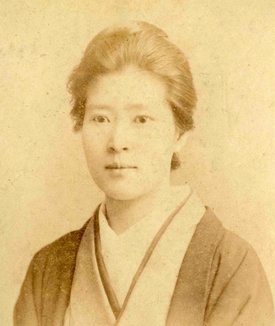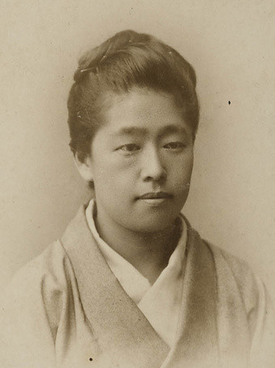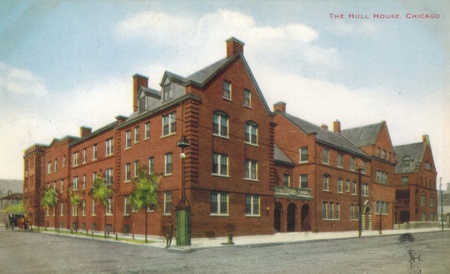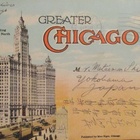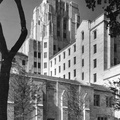It is no exaggeration to say that every Japanese person knows about Umeko Tsuda, the Japanese women's educator and founder of Tsuda University. Umeko came to Chicago twice.
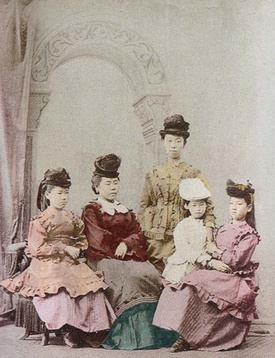
Umeko first set foot in Chicago in February 1872, when the Iwakura Mission, a group of more than 100 people, arrived in Chicago. The mission included five girls, and Umeko was one of them, the youngest at eight years old. The local newspapers barely mentioned the girls.
Before they arrived in Chicago, the American envoy, Mrs. DeLong, who accompanied them, wanted to attract attention by showing the girls in kimonos, and was reluctant to buy the girls western clothes even though they requested them. Frustrated, the girls finally begged Iwakura Tomomi repeatedly, and finally got some clothes in Chicago. As Mrs. DeLong had feared, the girls in western clothes probably did not deserve the media's attention.
However, the University of Chicago, an old system that had been expecting a visit from the delegation but was passed over, wrote a resentful article saying, "I had heard one of the girls was very beautiful, but I guess it wasn't much."
On February 27, 1892, exactly 20 years after the mission left Chicago, Umeko wrote a letter to the Chicago Record in which she reported that the education she had received in America was contributing to the development of women's education in Japan, and expressed her gratitude to America, calling it "her second home."
The second visit was in June 1898. Alice Breed, vice president of the General Federation of Women's Clubs, visited Japan during her world tour and appealed to the Ministry of Education to send Japanese representatives to the club convention to be held in Denver, Colorado a few months later. Umeko and Watanabe Fudeko were quickly selected, and the two traveled to Denver. Watanabe Fudeko would later become known as Ishii Fudeko, who founded Japan's first school for mentally disabled children.
Jane Addams, from Chicago, also attended the Denver convention. At the club's general meeting, Addams introduced the activities of the settlement "Hull House" that she had founded. Umeko also spoke about her own dispatch and how the Japanese Empress was deeply committed to women's education and women's issues, and said that Vice President Breed's visit to Japan had served as a bridge for "a mutual cooperation between East and West women." Fudeko said that she would like to stay in America for a few months and learn the truth about the various fields before returning home. When the two finished their speeches, dressed in kimonos, the audience, who had been watching them with amazed eyes, surrounded them, asking for handshakes and asking them a flurry of questions.
With the help of Vice Chairman Breed, the two men obtained express tickets on the Union Pacific Railroad from Denver to Chicago, and arrived at Chicago's Union Station on June 31, one day earlier than planned.
The Japanese Consulate in Chicago had opened the previous year, in 1897. Umeko and her friends had asked Consul Nose Tatsugoro to show them around Chicago, but because they had moved up their schedule, no one had come to the station to pick them up. With no other choice, the two stayed at the famous Palmer House and asked a hotel attendant where the Japanese Consulate was located. They were told, "I know a Japanese store," and when they went to the place he told them, it turned out to be a Chinese store.
This time, they asked a Chinese person in the shop where the Japanese consulate was located, and he introduced them to a Japanese shop called "Hinodeya." "Hinodeya" was a Japanese general store run by Nishi Kamenosuke, who was from Wakayama Prefecture. Finally, they met a Japanese person, and Nishi took them safely to the Japanese consulate.
At that time, the Japanese consulate was located in the Chamber of Commerce building at 148 Washington. One traveler commented, "I expected it to be very impressive, since it was the consulate of our empire, but in fact it was a seven-story building, and we rented two rooms on the third floor. I couldn't help but wonder if this was the consulate of one of the world's first-class countries."
On the following day, July 1, the two first visited the University of Chicago, accompanied by Consul Nose. On July 2, they visited Jane Addams' settlement, Hull House, and met Addams. Hull House was well known in Japan, and before they left, the two had received advice from the Minister of Education, Toyama, that "if you go to Chicago, be sure to see Miss Addams' social work." The two toured the facilities at Hull House, including the nursery and cafeteria.
Fudeko thought that daycare centers, where children could be left while their parents were working, were "a really good business to help parents." I wonder if they didn't exist in Japan yet. Laborers and singles who had been working all day came to the cafeteria. Consul Nose encouraged them to try something, but Umeko and her friends were reluctant and only had a cup of tea. It is recorded that the tableware was very clean.
The two parted ways the following day, July 3rd. Umeko headed east, but Fudeko stayed in the Midwest for a while. When former President Ulysses S. Grant visited Nagasaki in 1879, Fudeko spoke directly with Grant and received a signed photograph from him. She must have had deep feelings for the Lincoln statues in Chicago's Lincoln Park and Grant Park. In addition to Hull House, she also visited a number of social welfare facilities, including orphanages, children's hospitals, nursing homes, and public baths. There is no doubt that these visits had a major impact on Fudeko's thoughts and activities after she returned to Japan.
Following the devastation of the Great Chicago Fire in October 1871, Chicago rapidly industrialized and grew into a major city. Some people saw the city's energetic figure as being similar to Japan, which opened its doors to the world and quickly gained global national power. However, behind the enormous energy of Chicago, which attracted labor immigrants from all over the world, were the distortions of a wealthy society and the many foreign immigrant workers and their families struggling with life in sludge-filled slums.
After the Sino-Japanese War of 1894, Japan experienced remarkable economic growth, and the Socialism Study Group was founded in October 1898. The group's members included Katayama Sen, Kawakami Kiyoshi, and Murai Tomoyuki, all of whom had ties to Chicago. During their stay in Chicago, Umeko and Fudeko were searching for a new ideal for Japanese society and the image of women, and perhaps they saw themselves in the activities of Jane Addams and others who confronted the realities of Chicago.
© 2024 Takako Day


